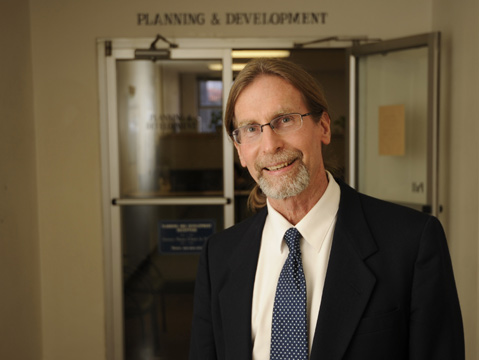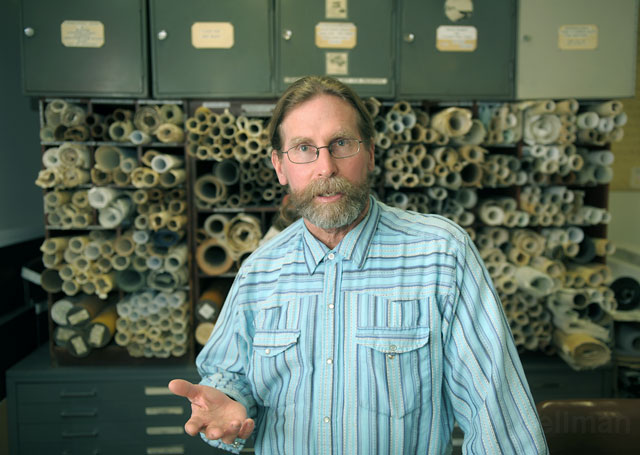Energy Division Head Retires, Recounts Spill
Kevin Drude Talks About New Era of Oil Production

Kevin Drude, head of the county’s Energy & Minerals Division, retired last week after nearly 26 years with the county. Drude — known for his long brunet hair, rancher attire, and love for horses — started as a county planner in 1990 after working as exotic dancer in Los Angeles while studying anthropology at UCLA.
Tasked with the difficult job of appeasing both environmentalists and oil industry representatives, Drude, 62, by many accounts, earned the respect of the conflicting sides. He made $167,800 annually, including benefits, according to Transparent California.
Drude recently sat down with the Santa Barbara Independent to talk about the evolution of oil production in Santa Barbara County, projects on the horizon, and the potential for positive change since the Refugio Oil Spill.
Santa Barbara County has the strictest energy regulatory oversight in the state. How did that come to be? The community here and the decision makers that represent them are so focused and intelligent on these issues. They get so involved that they keep us on our toes. I think in large part that is why we are the way we are. Look at all of the environmental groups: League of Women Voters, Get Oil Out!, Environmental Defense Center, Surfrider Foundation, etc.
Were there times when it was difficult to balance the interests of the oil industry and the environmentalists? No. Our zoning codes and policies are so straightforward; I just implement them on both sides. There is very little room for misinterpretation. This is exactly what you’re going to get. No more. No Less. And I tell the same thing to the environmental community. If you want more, you need to petition your decision makes to change the ordinance.
We are the only Energy Division in all of California. We hold industry to a standard. We don’t waiver. Nobody gets cut a break one way or the other. I find that [the industry] cooperates with us. They might not like the outcome, but when they walk in they know what they’re going to get every time.
How have the environmentalists changed since the 1990s? They haven’t changed at all. I knew Linda Krop in the ’90s. She was just getting started. She has been a stalwart of the local environmental movement. She’s been critical in writing policy letters to state and feds. I give her a lot of credit for the way the county regulates oil and gas.
What was the industry like in the ’90s? Different. They came in from the outside. They were all new — Chevron, ExxonMobil. They had a certain way of doing things in Texas. They would otherwise just get a zoning clearance or land use permit. We put them through a whole discretionary review: CEQA. That was all new to them. So there was some confrontation first. And some pretty tough meetings for them. But as our division matured in its role, so did they. They started realizing this is how we do things in this county.
Why don’t we see more development on the coast? The Board of Supervisors said in the ’80s: “We don’t want a proliferation of development on our Gaviota Coast. It’s too precious. We’re willing to accept permits and process them in one of two places. Period. We won’t accept applications otherwise.”
How has oil production developed in the county since you started? I was expecting full development along the coast, but that quickly changed in the early ’90s when the market dropped. The price of oil went to about $9 a barrel. Right now it’s at $29. A lot of those leases just sat dormant for years and years. They were big companies; they had a lot of investment, so they could afford that loss. But second-tier or third-tier production could not afford to build let alone operate.
How many applications for new oil wells are currently on your desk? Eight hundred or so. All of the projects we have now are steam or steam flooding.
How long does it take for an application to be completed? A couple of years. There are a number of rounds of back and forth. EIRs ideally take a year. They run anywhere from $250,000 up.
Let’s talk about natural seepage off the coast. The oil industry says drilling relieves pressure and decreases the seeps. That’s their argument, and there are different expert opinions about what is the truth.

What’s your professional opinion? It’s all about location. Where it is, what kind of oil it is, where is the gas, and how you are addressing it. There is never one good answer. Where is the zone? And how are you going to enter it? And what is the current problem? Are you going to exacerbate it? It would have to be evaluated under each scenario.
What about Venoco’s proposal to extend the reach of its oil drilling operations? They reapplied for the EIR. I have to see what it says. I’m sure they will go into that. The industries would love to say, “Hey, if you let us drill, you’re not going to have any oil on the beach anymore.” But we’ll see.
As the news broke about the spill, what was going through your mind? I was in a hearing, sitting at the board and they were making the final motions on the greenhouse gas emissions. My phone started ringing. It was the Office of Emergency Management. They said, “There’s a reported spill.”
I didn’t really think that much of it because we get calls every so often — the Summerland seeps, etc. People are always calling in. But I went back to my office and my phone started ringing. Then it became more and more real. I went to my staff and said, “I think we have a spill.” We just jumped on it. Then it was a roller coaster.
Has there been anything similar? The 1997 spill at Platform Irene. There are tiny little platform releases or upsets. They might have a pipeline spill release water at a facility. Nothing to this magnitude.
What do you think about the accusations that it took a long time for the Coast Guard to arrive? I think they are still talking about that. There are always things that we could do better. I don’t like to criticize other agencies, because I don’t know what their protocol was. But when I dealt with the [Coast Guard], I found that they were very helpful to what we were doing.
There was pretty good communication. They gave me immediate access to the Emergency Operations Center. It was confusing, and there are always bumps in the road, but I don’t really have any criticism of how they performed. But I’m sure they have their own internal criticism. You can always learn.
What is one outcome from the spill? We didn’t really deal with Pipeline and Hazardous Materials Administration (PHMSA) before. We were just going along on concurrent paths and now we’re meshed. We meet monthly. I hope that continues. They seem to want to continue it. They are very enthusiastic. It’s a new era.


